How To Build A Chicken Run: Crafting A Safe Haven
- February 13, 2024
- 0 comment
Building a chicken run can seem like a daunting task, but with a little bit of planning, research, and elbow grease, it can also turn into a rewarding DIY project that enhances your backyard and provides a safe, spacious environment for your chickens. As someone who recently embarked on this journey, I wanted to share my experiences, insights, and a few tips that might help others looking to do the same. This review will cover everything from choosing materials to comparing different designs, and I’ll share my personal perspective on what worked, what didn’t, and why.

If you’re contemplating the idea of building a chicken run, understand that creating a secure area where your chickens can explore the outdoors while being protected from predators is crucial for their safety and happiness. Presented here is an elaborate five-step guide to constructing a chicken run. This guide is enriched with illustrative photographs and exclusive tips designed to navigate you smoothly through each phase of the project.
List of How To Build A Chicken Run:
- Plan How Big the Chicken Run Should Be
- Set Your Posts
- Attach the Wire Fencing
- Create Your Frame
- Add a Door
What Exactly is a Chicken Run?
A chicken run refers to a securely fenced area connected to the chicken coop, which serves as the primary living space for chickens. It is designed to protect chickens from predators that may attack during the day, such as dogs, foxes, hawks, and eagles, despite the common misconception that most predators are nocturnal.
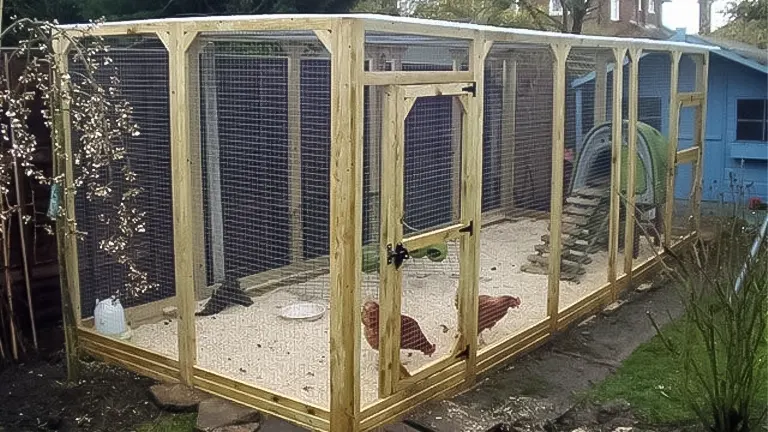
Ensuring the safety of your chickens from these threats is crucial for their well-being. Additionally, a chicken run plays a vital role in preserving the integrity of your lawn, garden, and landscaping.
Chickens have a natural inclination to forage, which includes digging up plants, eating leaves, disturbing mulch, and generally causing disarray in garden spaces. By confining your chickens to a run, you not only safeguard them from potential danger but also protect your outdoor spaces from the damage they can cause.
Moreover, a well-designed chicken run prevents chickens from straying into unsafe areas, such as roads, or causing issues in neighboring properties. This containment is essential for maintaining good relations with neighbors and ensuring the safety and security of your chickens.
Choosing the Right Design and Materials
Choosing the right design and materials for a chicken run is a crucial early step that directly affects both the project’s outcome and the well-being of your chickens. In the initial stages of planning my chicken run, it became clear that there was a wide range of options available, from simple fenced areas to more elaborate setups with roofing, predator-proof bases, and automated gates.
My approach to deciding on the most suitable design was to conduct an in-depth review of the various options, paying close attention to their potential to meet the unique needs of my chickens. After careful consideration, I opted for a design that was medium in size and semi-permanent, utilizing wooden frames for robust support and hardware cloth for its proven effectiveness in deterring predators.
This particular choice struck an optimal balance between ensuring long-term durability, providing adequate security against potential threats, and offering flexibility to accommodate the specific living conditions my chickens needed. This process underscored the vital role that selecting the right materials and design plays in the successful construction of a chicken run.
Materials:
The specific amounts needed will vary based on the dimensions of the run you plan to construct!
- 4×4 wooden fence posts
- Optional: Quikrete (or other concrete mix)
- 2×4 boards or 1×6 boards
- 1/2” welded wire fencing or 1” welded wire fencing
- Staples (U-shaped nails)
Tools:
- Shovel
- Hammer
- Saw
- Wood nails/screws
- Post hole digger
- Cordless screwdriver
- Level
Step-By-Step Guide To Making A Chicken Run
Step 1: Plan How Big the Chicken Run Should Be
When planning the size of your chicken run, start by considering the number of chickens you intend to keep, as well as their breed, since different breeds have varying space requirements. A general rule is to allocate at least 10 square feet of run space per chicken. This space is necessary to prevent overcrowding, reduce stress, and minimize the spread of diseases among the chickens.
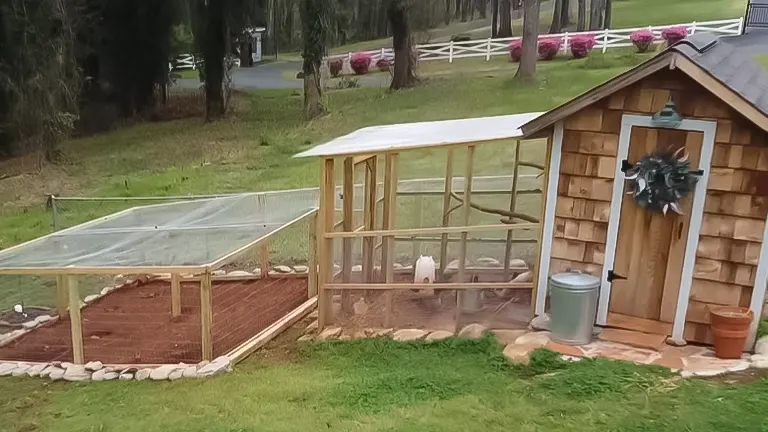
Additionally, take into account the layout of your backyard, the placement of the coop, and any future expansions you might consider. It’s also important to plan for enough space to include structures like dust baths, perches, and sheltered areas within the run for the chickens to use during bad weather.
Furthermore, evaluate the terrain of your intended location for the chicken run. Flat land is preferable for ease of construction and maintenance, but if you’re working with uneven terrain, you might need to consider additional preparations like leveling the ground or incorporating terraced sections to ensure the run is secure and usable.
Think about the direction of the sun and prevailing winds to position the run in a way that provides adequate sunlight and shelter for the chickens. This planning stage is critical in creating a comfortable, functional, and safe outdoor area for your chickens to thrive.
Step 2: Set Your Posts
Setting your posts correctly is fundamental for constructing a stable and durable chicken run. Begin by marking the perimeter where the posts will be placed, using stakes and string to ensure straight lines. Holes for the posts should be dug at least 2 feet deep to provide a firm foundation, especially in areas prone to high winds or soft soil.
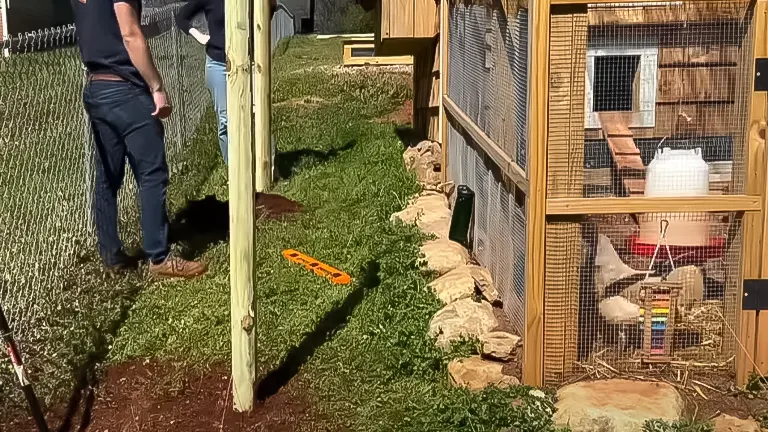
The spacing between posts should not exceed 8 feet to maintain the structural integrity of the fencing and frame. Using pressure-treated wood or metal posts can offer longevity and resistance against rot and pests.
After digging the holes, set each post in place, using a level to ensure they are straight. Pouring a concrete footing around the base of each post can significantly enhance stability, though this may not be necessary for all soil types.
Once the posts are set and the concrete (if used) has cured, it’s important to double-check the alignment and height of all posts to ensure a uniform and level top line. This preparation is crucial for attaching the wire fencing and creating the frame of the chicken run, impacting the overall durability and security of the enclosure.
Step 3: Attach the Wire Fencing
Attaching the wire fencing to the posts securely is key to keeping your chickens safe from predators and contained within the designated area. Use hardware cloth or welded wire fencing with small enough mesh to prevent predators from reaching in and chickens from escaping.
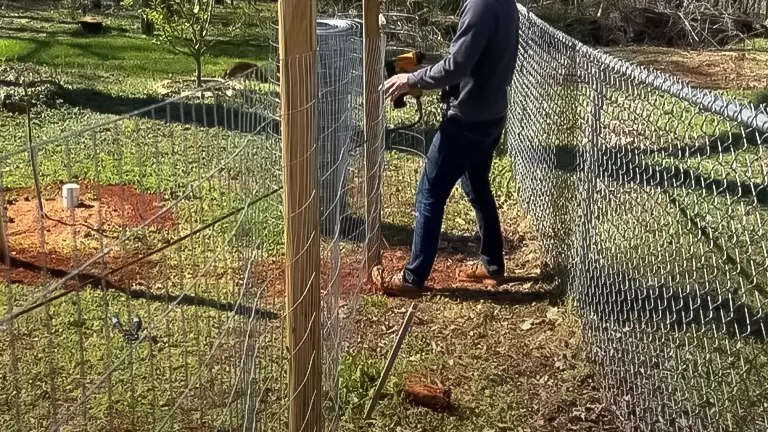
Start by unrolling the fencing along the outside of the posts, ensuring it’s taught to avoid sagging. Use fencing staples or heavy-duty zip ties to attach the fencing to the wooden or metal posts at regular intervals, ensuring there are no gaps or loose sections.
For added security, consider burying the bottom of the wire fencing at least 12 inches into the ground to deter digging predators such as foxes and dogs. Alternatively, you can lay the wire mesh outward in a trench around the perimeter and cover it with soil or rocks, creating a barrier that discourages digging.
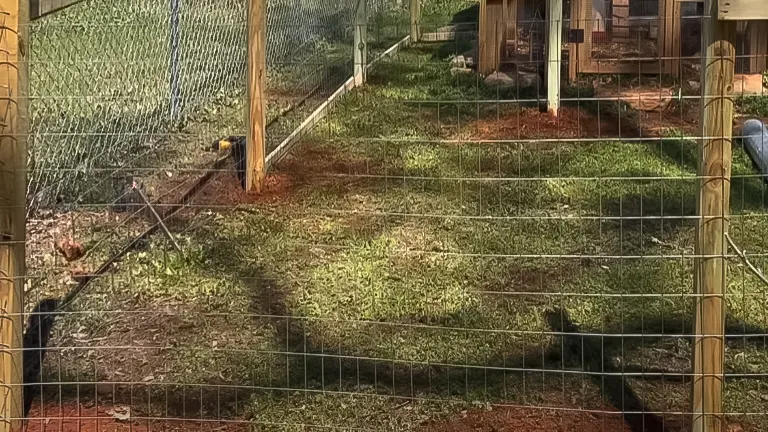
Pay special attention to the corners and gate areas, as these are often the weakest points in the run’s defense. Ensuring the wire is properly attached and secure around the entire perimeter is essential for the safety and well-being of your chickens.
Step 4: Create Your Frame
Creating a frame for the chicken run adds structural integrity and supports the wire fencing. The frame can be constructed from wood or metal, depending on personal preference and the materials used for the posts.
If using wood, ensure it is pressure-treated or naturally resistant to rot and pests to extend the lifespan of the run. The frame should be designed to cover the top, sides, and door of the run, providing a complete enclosure that protects chickens from aerial and ground predators.
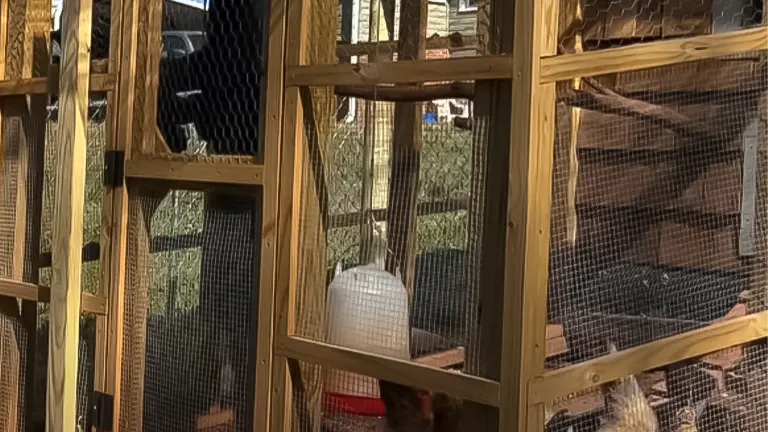
Begin the framing process by attaching horizontal support beams between the posts at the top, middle, and bottom of the run. These beams reinforce the posts and provide a framework to which the wire fencing can be securely attached.
For the top of the run, especially in larger enclosures, additional crossbeams or a grid of beams may be necessary to support a roof or netting that prevents chickens from flying out and predators from entering. Ensuring the frame is solid and well-constructed is crucial for the overall stability and durability of the chicken run.
Step 5: Add a Door
Adding a door to your chicken run is necessary for access to the enclosure for feeding, cleaning, and interacting with your chickens. The door should be sturdy, fit snugly within the frame, and be equipped with reliable locks to keep out predators.
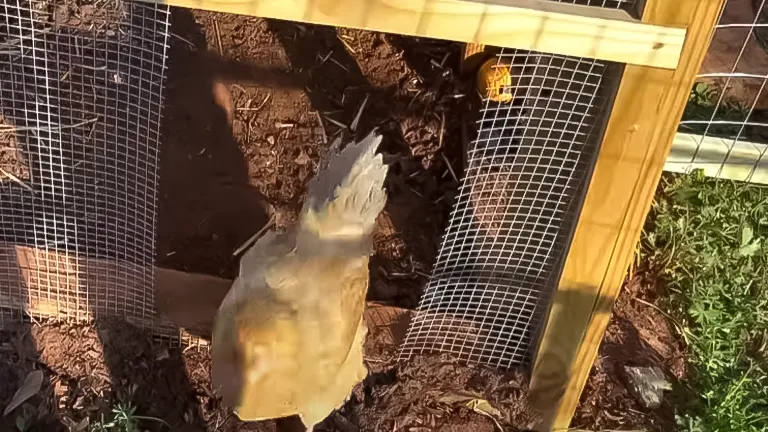
Construct the door frame using the same materials as the rest of the run’s frame, ensuring it’s well-integrated into the structure for added security and stability. The door itself can be made of wood or metal and should be covered with the same type of wire fencing used for the rest of the run to maintain consistency and
Lessons Learned and Tips for Future Builders
- Plan meticulously, but be prepared to adapt. No matter how much you plan, you’ll likely need to make adjustments.
- Invest in quality materials from the start. It might cost more upfront, but it will save you time and money in the long run.
- Don’t underestimate the importance of security. Predators are crafty, so every detail matters, from the depth of the buried hardware cloth to the strength of the door latches.
- Enjoy the process. It’s easy to get caught up in the stress of building, but remember why you’re doing it. The reward of seeing your chickens happily clucking away in their safe, new run is worth every moment of effort.
Additional Guidance and Strategies:
- Utilizing a chicken run significantly minimizes the risks to your chickens compared to free-ranging, but enhancing protection based on local predator types is crucial. Incorporating an extra layer of hardware cloth around the run can provide robust defense against common threats such as raccoons and foxes. This additional barrier can be a vital deterrent, reinforcing the security of your chickens’ outdoor environment.
- While your locality may seem secure, it is advisable to house your chickens within their coop during nighttime. This practice is essential for their safety. It is equally important to meticulously review and verify your construction plan and measurements. Careful planning helps avoid the construction of a run with an impractical layout or dimensions, which can result from hastened or imprecise planning processes.
- Enrichment activities are crucial for maintaining happy and healthy chickens. Integrating playful elements into your chicken run, such as chicken swings or treat balls, can significantly enhance the well-being and enjoyment of your chickens. These additions provide mental and physical stimulation, contributing to a more dynamic and engaging environment for your flock.
- For those who already manage a coop, the inclusion of roosting bars is a well-known necessity. However, adding roosting options outside in the chicken run can offer your chickens more versatility and comfort in their outdoor space. This setup allows them to enjoy the outdoors while still engaging in natural roosting behaviors.
- It’s advisable to store chicken feed away from the run to avoid attracting rodents and other pests. While some feeder designs that conceal feed may appear to be a safe option for outdoor use, storing feed within the coop is a more effective strategy to deter pests from encroaching on your chickens’ outdoor area. This practice helps maintain a clean and safe environment for your flock, minimizing the risk of pest-related issues.
Related Articles:
- Best Bedding For Chickens
- Best Safe Chicken Coop Heater
- 8×8 Chicken Coop Plans
- Turning a Shed Into a Chicken Coop
- How to Make a Chicken Coop Out of Pallets
- Best Sand for Chicken Coop
- How To Insulate a Chicken Coop
- How To Heat a Chicken Coop
- How To Keep Water from Freezing in Chicken Coop
- How to Build a Chicken Coop
- How To Build Chicken Nesting Boxes
- How to Raise Happy and Healthy Chickens in Your Backyard
- When Can Chicks Go Outside? Timing and Tips for a Smooth Transition
- 12 Reasons why Ducks are Better than Chickens
- Best Automatic Chicken Coop Doors 2024: Expert Reviews & Buyer’s Guide
- Best Fans for Chicken Coop 2024: Effective Cooling Solutions Reviewed
Final Thoughts
Constructing a chicken run is a rewarding project that significantly enhances the safety and quality of life for your backyard chickens. By carefully planning the size, ensuring the structure is secure from predators with appropriate fencing and additional safety measures, and incorporating enrichment activities, you can create a space that is both functional and enjoyable for your chickens. Remember, the success of your chicken run lies in the details—proper planning, choosing the right materials, and considering the needs of your chickens are all critical components. With dedication and careful execution, you can build a chicken run that provides your flock with a safe, stimulating, and comfortable outdoor environment.
Frequently Asked Questions
- What materials do I need to build a chicken run?
Essential materials include posts (wood or metal), hardware cloth or welded wire fencing, latches, hinges for the door, and possibly concrete for setting posts. Optional materials might include a tarp or roofing material for weather protection. - How big should my chicken run be?
Each chicken should have at least 10 square feet of space in the run. Size adjustments should be based on the number of chickens you have and the available space in your yard. - Can I build a chicken run on uneven ground?
Yes, but it may require additional steps like leveling the ground or building a raised or terraced structure to ensure stability and security. - What type of fencing is best for a chicken run?
Hardware cloth or welded wire mesh are recommended due to their durability and smaller openings, which help protect against predators. - How do I protect my chicken run from predators?
Bury the fence at least 12 inches underground or lay it outward in a trench to deter diggers. Ensure the mesh size is small enough to prevent predators from reaching in, and secure the run’s top with netting or a solid roof. - Do I need a roof over my chicken run?
A roof or netting is advised to provide protection from aerial predators and harsh weather conditions, though specific needs may vary based on your location and predator types. - How can I make my chicken run enriching for my chickens?
Include features like perches, swings, dust baths, and treat dispensers to encourage natural behaviors and provide entertainment. - Should the chicken run be attached to the coop?
Yes, attaching the run to the coop allows chickens to move freely between the sheltered coop and the outdoor run, facilitating a more natural and enriching environment. - How often should I clean the chicken run?
Regular cleaning is essential to maintain health and hygiene. Frequency depends on the size of the run and the number of chickens, but a general guideline is to perform a thorough clean every few weeks with spot cleaning as needed. - Can I build a chicken run myself or should I hire a professional?
Building a chicken run can be a DIY project if you have basic construction skills and tools. However, hiring a professional might be beneficial if you’re seeking a more complex or large-scale design, or if you’re not comfortable with construction tasks.
We’d love to hear from you! Share your personal experiences and tips on building a chicken run in the comments section below. Your insights and advice could greatly assist fellow enthusiasts in creating their own perfect backyard setup. Whether it’s innovative ideas, challenges you faced, or recommendations on materials, every piece of input helps the community make informed decisions and build safer, happier homes for their chickens!

Edward Smith
Forestry AuthorWoodworking is about more than crafting; it's a harmonious connection with nature, mastering tools, and preserving our environment. I'm here to share my knowledge and experiences with you, forging a future where we can embrace wood's beauty and utility while safeguarding our forests' health and diversity.






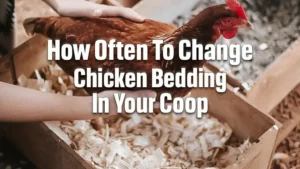

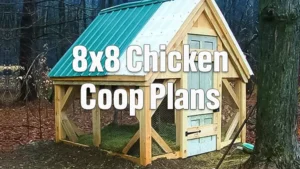




Leave your comment